He thought he knew better than his people; thought he could, through sheer force of will, change a public mindset centuries in the making. He was an iconoclast (literally) 2000 years before the term would be coined by medieval Byzantines, but within a couple of decades after his rule, the enemies he’d created had obliterated nearly every trace of his reign, as well as the monotheistic religion he had promulgated as a state faith. A victim of an histoicide of staggering proportions, his name was virtually excised from the public record, his monuments altered and defaced, and he was forgotten for almost three millennia.
Join me, if you will, in the Cave of the Moonbat, where tonight we’ll take a look at the sort of thing that would cause a civilization to try to erase one of its own leaders from history. With all the talk of Romney’s misunderstanding of the nature of freedom and religion in America, not to mention the ongoing historical embarrassment that is the Bush Administration, it only seems appropriate. It’s not meant, however, to assert that either the clearly-megalomaniacal President, or his would-be successor is the mental or spiritual equal of the thoroughly remarkable “heretic pharaoh” Amenhotep IV, who called himself “Akhenaton” and whom history sometimes terms the world’s “first individual.”
He was as bullheaded, stubborn, and patronizing as George W. Bush, but utterly unlike The Decider in most of the really important ways. While our President is doomed to historical derision and mockery, Akhenaton is alternately known as “the first scientific mind,” the “first romantic,” and the “first revolutionary” in human history. For 20 bizarre years, he and his beloved wife Nefertiti transformed Egypt from a priest- and temple-dominated polytheism with a largely secularized government to an imperial theocracy holding forth as a state religion what was probably the world’s earliest monotheistic faith. Akhenaton was also responsible for initiating the chain of events that led to what may have been the first bona fide revolution ever recorded.
Before we traipse off into the desert, though, I should mention a couple of matters to keep in mind when working with the history of Ancient Egypt. The first thing we have to get our heads around is that when talking about these guys, “Ancient” means really, really ancient. Commonly-cited dates for the founding of the kingship of Egypt are around 3000 BCE; Akhenaton’s rule began around 1350 BCE. This means that as much time – and history – had elapsed between the ages of Menes-the-Egypt-uniter and Akhenaton as has between the Roman emperor Constantine and the Commander Guy. Through rise and decline, invasion and expansion, and all the other things that happen to civilizations besides, the people of Ancient Egypt could trace their story as far beyond the mists of prehistory as anyone, and much further than most.
Weird Historical Sidenote: The other matter alluded to above relates to the rendering of hieroglyphs into modern alphabets. The Egyptians themselves had several ways of turning sounds into symbols, and these naturally changed over the course of the ages. The fact that we use the same symbols to convey different sounds doesn’t help things (not to mention that much scholarship has gone through a double-translation cycle of Egyptian-to-Arabic-to-English), and is part of the reason why Egyptian words can be spelled in many different ways.
It’s also why early Egyptologists rendered the name of the chief god as “Ra,” which usually leads to the modern reader hearing a soft “a” in his or her head (i.e., “Rah”). As guys like Dr. Daniel Jackson of SG-1 resurrected more of the language of Ancient Egypt, however, it became apparent that the name was probably pronounced more like “Ray.” To correct for this, many later scholars have taken to scribing the sun god’s name as “Re” – and this is but one, simple, two-letter example. When one starts talking about aspects of the god Horus being subsumed by an abstract concepts of the sun god’s power and turned into some kind of composite deity, things can get really confusing, so I’ve elected to go with the most traditionally accepted (if not phonetically accurate) renderings of the symbols, and extend my apologies to any Egyptologists enraged by this decision.
But Mr. President, what if ours gods are human/animal hybrids?
Over all that time, a complex religious system developed around a polytheistic understanding of the natural world. Ancient Egyptian Religion was based on the same birth-death-rebirth cycle the people saw every year with the flooding of the Nile – just as the god Set had killed his brother Osiris, only to see the latter resurrected by his sister-wife Isis, so, too, did the floods replenish the soil with rich and fertile silt for the new year’s crop. Dozens of other minor and local deities vied for attention, each with its (the pronoun is appropriate: many of these gods were chimeras of the sort the President was presumably warning us about a couple of SOTUs ago) own temple and attendant priests.
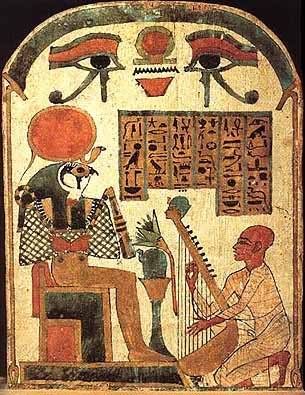 At the pinnacle of the pantheon stood the sun god Ra, whose cult center at Iunu (Heliopolis, near modern Cairo) went back to the Old Kingdom Period (2575-2150 BCE; 4th-8th Dynasties). Like most things Egyptian, Ra’s life was pretty cyclical: every day, he sailed the Barge of the Sun across the sky in the company of his vizier Thoth and his daughter Ma’at, only to face a dangerous journey across the underworld before the next morning’s rebirth. Liking the symbolism of Ra’s shining benevolence, kings of Egypt began to claim descent from the sun god during the 4th or 5th Dynasties, and with the passing of centuries and subsequent dynasties, Ra-worship became the province of the pharaoh (Egyptian for “Great House”).
At the pinnacle of the pantheon stood the sun god Ra, whose cult center at Iunu (Heliopolis, near modern Cairo) went back to the Old Kingdom Period (2575-2150 BCE; 4th-8th Dynasties). Like most things Egyptian, Ra’s life was pretty cyclical: every day, he sailed the Barge of the Sun across the sky in the company of his vizier Thoth and his daughter Ma’at, only to face a dangerous journey across the underworld before the next morning’s rebirth. Liking the symbolism of Ra’s shining benevolence, kings of Egypt began to claim descent from the sun god during the 4th or 5th Dynasties, and with the passing of centuries and subsequent dynasties, Ra-worship became the province of the pharaoh (Egyptian for “Great House”).
With all that royal support, Ra enjoyed the most consistent worship during the whole of the Egyptian pantheon’s run, but in his purest, sun-god-only form, he wasn’t really considered a “people’s deity.” Oh, sure, they’d take the feast days off from work and enjoy the sacrifices at Ra’s temples, and his cult remained strong in Heliopolis, but most Egyptians paid more attention to the gods and demigods that resided in their locale, or who took a more active role in their day-to-day lives.
The strength of other gods – and their attendant cults – were more subject to the whims of politics or fads among the people, like the ascendancy of Theban favorites during a period of pharaohs from Thebes, and sometimes new interpretations of the faith (or conniving business practices, depending upon how you look at it) would result in gods assimilating one another’s aspects. By the 9th Dynasty (ca. 2100 BCE), Ra had adopted facets of several other deities, as in Ra-Horakhty, reflecting the sunrise-oriented aspect of the god Horus, and Amun, who was positively Borg-like in his/her assimilation of other gods’ spheres of influence.
Weird Historio-Literary Sidenote: H.P. Lovecraft (1890-1937), master of horror and all things Cthulu, once ghost-wrote a piece for Harry Houdini that presents a terrifying, florid, and wholly inaccurate picture of the Ancient Egyptian predilection to combine things; presumably this was the source material for the President’s urging of national bedwetting at the imminent human/animal hybrid threat:
I saw the horror and unwholesome antiquity of Egypt, and the grisly alliance it has always had with the tombs and temples of the dead. I saw phantom processions of priests with the heads of bulls, falcons, cats, and ibises; phantom processions marching interminably through subterraneous labyrinths and avenues of titanic propylaea beside which a man is as a fly, and offering unnamable sacrifice to indescribable gods. Stone colossi marched in endless night and drove herds of grinning androsphinxes down to the shores of illimitable stagnant rivers of pitch. And behind it all I saw the ineffable malignity of primordial necromancy, black and amorphous, and fumbling greedily after me in the darkness to choke out the spirit that had dared to mock it by emulation.
…(snip)…
Perhaps the most leeringly blood-congealing legends are those which relate to certain perverse products of decadent priestcraft – composite mummies made by the artificial union of human trunks and limbs with the heads of animals in imitation of the elder gods. At all stages of history the sacred animals were mummified, so that consecrated bulls, cats, ibises, crocodiles and the like might return some day to greater glory. But only in the decadence did they mix the human and the animal in the same mummy – only in the decadence, when they did not understand the rights and prerogatives of the ka and the soul.
The Megatemples of Amun-Ra
Religions change over time: philosophers uncover hitherto-hidden truths, cultural mores evolve (or decline), war and trade introduce new ideas, and charlatans add their own self-serving twists that somehow find their way into the dogma (we can see this in the doctrine surrounding the Rapture – not found anywhere in Bible, undiscovered until a British evangelical preacher discerned it in the 19th century, it’s now national policy). So it was with the cult of Amun-Ra, “Amun” being the creative air/wind god who came to represent the “hidden aspect” of the sun. Centered in Thebes, his cult credited Amun with every victory and advance they could, presaging the techniques of Christian missionaries in Middle Ages-Europe by more than two thousand years.
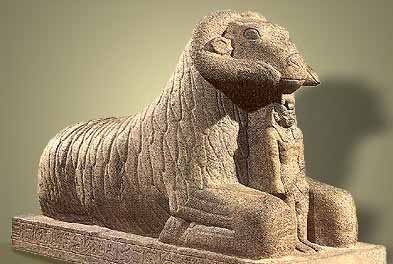 For a while, every conquest brought a new aspect to Amun-Ra. He became the protector of the oppressed during the occupation of northern Egypt by the Hyksos during the Second Intermediate Period (1630-1520 BCE), and when the invaders were evicted by the armies of the 18th Dynasty, Amun-Ra was there to take on the role of dispenser of justice – an aspect that later led to the confession of sins becoming part of his worship. He added fertility to his sphere when the Egyptians conquered Kush and declared that their chief god (represented by the ever-fertile ram) was, in fact, Amun-Ra. This theme was expanded upon when his worship was encouraged during the New Kingdom period (1539-1075 BCE) as a means of re-unifying the nation after the turmoil of Hyksos rule.
For a while, every conquest brought a new aspect to Amun-Ra. He became the protector of the oppressed during the occupation of northern Egypt by the Hyksos during the Second Intermediate Period (1630-1520 BCE), and when the invaders were evicted by the armies of the 18th Dynasty, Amun-Ra was there to take on the role of dispenser of justice – an aspect that later led to the confession of sins becoming part of his worship. He added fertility to his sphere when the Egyptians conquered Kush and declared that their chief god (represented by the ever-fertile ram) was, in fact, Amun-Ra. This theme was expanded upon when his worship was encouraged during the New Kingdom period (1539-1075 BCE) as a means of re-unifying the nation after the turmoil of Hyksos rule.
Weird Historical Sidenote: The cult of Amun-Ra remained influential through the 20th Dynasty (to 1075 BCE), but had a difficult time recovering from the Akhenaton-related events babbled about below. Still, Amun-Ra had an oracle as late as the time of Alexander the Great, and was still highly regarded enough for the conqueror to traipse out into the desert to be declared a Son of the Sun and descendant of Amun-Ra, effectively coronating Egypt’s first Macedonian pharaoh. Today, the god is remembered chiefly through the word ammonia – the Romans called it the “Salt of Amun” because they collected it from a pool in the Libyan desert near to one of Amun-Ra’s ancient temples.
…but I digress – the odiferous end of the deity’s career is getting outside the province of this story. During the time of Akhenaton, the cult of Amun-Ra was immensely wealthy and powerful, with megatemples and vast congregations scattered up and down the Nile. There was much money to be made from pilgrimages and the like, and entire industries sprang up near the larger temples to serve the tens of thousands (100s of thousands, in some cases) of worshippers who passed through every year. From selling food to renting rooms to fashioning trinkets, a significant portion of the economy came to rely upon the priests, temples, and cult of Amun-Ra.
Those Crazy Cats of the 18th Dynasty
 With the defeat of the Hyksos interlopers around 1539 BCE, Egypt was set to embark upon one of its more colorful dynasties. The 18th line of rulership included some figures who are diary-worthy in their own right, like Hatshepsut, Egypt’s longest reigning female pharaoh, and King Tut, whose odd story is inexorably bound with Akhenaton’s.
With the defeat of the Hyksos interlopers around 1539 BCE, Egypt was set to embark upon one of its more colorful dynasties. The 18th line of rulership included some figures who are diary-worthy in their own right, like Hatshepsut, Egypt’s longest reigning female pharaoh, and King Tut, whose odd story is inexorably bound with Akhenaton’s.
For nearly two thousand years, things had been going passably well, theologically speaking. The people enjoyed a rich spiritual life, associating the natural cycles of life with their many gods, making pilgrimages to great temples, and harvesting the fruits of their devotion with a timeless understanding of the order of the universe. Politically, Egypt was organized; militarily, she was mighty. By the reign of 9th king of the 18th dynasty, Akhenaton’s father Amenhotep III (the name means “Amun is content”), things were fairly peaceful, fairly settled, and humming along fairly nicely.
Amenhotep III ruled for 38 years, during which he didn’t do much but play aggressive footsies with the Babylonians, Nubians, and Mitanni, and add on to the already-gigantic temple complex at Karnak. He had several wives and daughters, but only two sons. The elder of these, Thutmose, took on the traditional role of the crown-prince-in-waiting, that of a priest of the god Ptah in Memphis, but died sometime late in his father’s reign. Thus, when Amenhotep III went off to get his ka weighed against a feather, it was the younger son, Amenhotep IV, who succeeded to the throne around 1352 BCE, though it is unclear if there was a period of coregency (possibly with his mother, Queen Tiye), and, if there was, whether it lasted 1, 2, or 12 years.
The Pyramid of Church and State
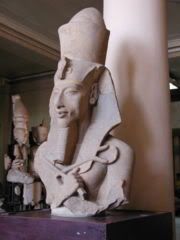 He’d been raised in a traditional household, worshipping Amun-Ra like everybody else, but he seems to have developed at an early age a reverence for the earlier times, that simpler age when pharaohs did the sun-worshipping on behalf of the people and the gods weren’t amalgamations of one another’s aspects. Perhaps his evolving theology grew out of a Bushlike desire to centralize dictatorial powers, or maybe he earnestly felt himself a prophet, sent by a monotheistic god to lead his people away from pantheonic madness – it’s hard to say. The measures taken by his enemies to obliterate evidence of his reign makes it difficult to say with certainty what motivated Amenhotep; though possible, it doesn’t seem likely that he would be found at the ends of the either/or extremes, but instead would take inspiration from a mix of avarice, compassion, egoism, and intellect.
He’d been raised in a traditional household, worshipping Amun-Ra like everybody else, but he seems to have developed at an early age a reverence for the earlier times, that simpler age when pharaohs did the sun-worshipping on behalf of the people and the gods weren’t amalgamations of one another’s aspects. Perhaps his evolving theology grew out of a Bushlike desire to centralize dictatorial powers, or maybe he earnestly felt himself a prophet, sent by a monotheistic god to lead his people away from pantheonic madness – it’s hard to say. The measures taken by his enemies to obliterate evidence of his reign makes it difficult to say with certainty what motivated Amenhotep; though possible, it doesn’t seem likely that he would be found at the ends of the either/or extremes, but instead would take inspiration from a mix of avarice, compassion, egoism, and intellect.
If the priests of Amun-Ra weren’t at first concerned that the status quo was going to be interrupted by the new king, they were by the third year of his rule. That’s when Akhenaton – he began styling himself “Favored by the Aten” since early in his reign, but may not have made the change official until his 5th year in power – threw himself a Heb Sed, a “Feast of the Tail” which rarely-violated tradition said could only be celebrated after a pharaoh’s 30th year of rule. The jubilee involved huge processions, much pageantry, and a whole lot of temple visitation. Akhenaton was inviting people to come pray in his newly-designed, open-to-the-sun temple at Karnak, and promoted his own cult to a position previously enjoyed by the priests of Amun.
His take on religion centered upon the solar disc itself (the “Aten”), which he regarded as an all-encompassing deity unencumbered by the complexities of manifestations, purviews, inter-cult politics. The Aten was the life-giving force upon which all things depended, and only the pharaoh – the descendant of the sun god and faithful intercessor in all matters solar – could show the people the path to salvation. When represented artistically, the rays emanating from the sun end in hands, denoting either the Aten’s munificent benevolence or the desire of Akhenaton to stick his paws into every aspect of Egyptian culture and life.
In a speech prior to his Sed festival, Akhenaton used the disrepair of the temples at Karnak to bolster his argument that the only thing eternal was the Aten, and when the jubilee started, he sprung a heretofore unheard-of artistic style upon his subjects. In this new school, artists were encouraged to portray and even exaggerate the distinguishing features of the royal family, which has led to a rousing academic argument about whether or not Akhenaton suffered from some sort of genetic malady. He is often shown with a pot-belly and elongated face, and though the beauty of his wife Nefertiti is celebrated by one of the most famous works of antiquity:
…other portrayals of her are far less flattering. The emphasis on non-stylized scenes of daily life extended to the almost Camelot-ish images of the pharaoh kissing his wife, hanging out with his kids, or gnawing on a bone at the supper table.
City of God
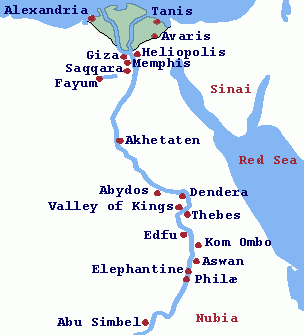 In the fifth year of his rule, Akhenaton took his most dramatic step to date when he vacated the royal palace at Thebes in favor of constructing a brand-new city of his own in a cliff-ringed valley about 360 miles south of Heliopolis. He named the place Akhet-Aten, or “Horizon of the Aten,” and in moving his capital there, he both isolated himself (this had both pros and cons) and removed the center of power from where the priests of Amun were accustomed to having it (which had only pros, as far as Akhenaton was concerned). The modern name for the spot is El-Amarna, and the next 15 years or so of Egyptian history is often called the Amarna Period.
In the fifth year of his rule, Akhenaton took his most dramatic step to date when he vacated the royal palace at Thebes in favor of constructing a brand-new city of his own in a cliff-ringed valley about 360 miles south of Heliopolis. He named the place Akhet-Aten, or “Horizon of the Aten,” and in moving his capital there, he both isolated himself (this had both pros and cons) and removed the center of power from where the priests of Amun were accustomed to having it (which had only pros, as far as Akhenaton was concerned). The modern name for the spot is El-Amarna, and the next 15 years or so of Egyptian history is often called the Amarna Period.
As his city rose up around him, the political situation around the Middle East crumbled. Later generations of Egyptians portrayed Akhenaton as having a Rumsfeldian sense of foreign policy, but he wasn’t quite as disassociated with reality as the disgraced former SecDef, though the record wasn’t clear at all until the discovery of the Amarna Letters in 1887. These 350 or so tablets, written in cuneiform (the diplomatic lingua franca of the day) were divvied up by the imperialist powers for their national trophy rooms – about 200 now reside in Berlin, 80 in the British Museum – but once deciphered, they provided a fascinating look at political discourse between the pharaoh and the local leaders at the edges of his empire.
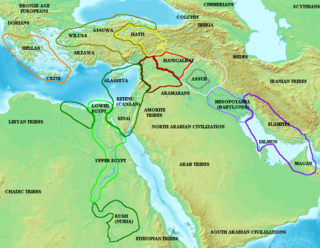
Map of the ancient Near East during the Amarna period, showing the great powers of the period: Egypt (green), Hatti (yellow), the Kassite kingdom of Babylon (purple), Assyria (grey), and Mittani (red). Lighter areas show direct control, darker areas represent spheres of influence. The extent of the Achaean/Mycenaean civilization is shown in orange. Wikimedia
Some of the letters – they’re all incoming mail; no outgoing memos from Akhenaton were found – sound like they could have been written by Nancy Pelosi:
At the feet of my lord, my sun, I fall down seven times and seven times. Let the king, my lord, know that Gubla, your handmaid from ancient times, is well.
However, the war of the ‘Apiru against me is severe. (Our) sons (and) daughters are gone, (as well as) the furnishings of the houses, because they have been sold in Yarimuta to keep us alive. My field is “a wife without a husband,” lacking in cultivation. I have repeatedly written to the palace regarding the distress afflicting me, . . but no one has paid attention to the words that keep arriving. Let the king heed the words of his servant…
while others accuse rival kings – and even the pharaoh himself – of double-dealing exploits worthy of the vilest Bushco escapades:
I…asked your father, Mimmureya, for statues of solid cast gold, one of myself and a second statue, a statue of Tadu-Heba (Tadukhepa), my daughter, and your father said, “Don’t talk of giving statues just of solid cast gold. I will give you ones made also of lapis lazuli. I will give you, too, along with the statues, much additional gold and (other) goods beyond measure.” Every one of my messengers that were staying in Egypt saw the gold for the statues with their own eyes. Your father himself recast the statues (i)n the presence of my messengers, and he made them entirely of pure gold….He showed much additional gold, which was beyond measure and which he was sending to me. He said to my messengers, “See with your own eyes, here the statues, there much gold and goods beyond measure, which I am sending to my brother.” And my messengers did see with their own eyes! But my brother (ie: Akhenaten) has not sent the solid (gold) statues that your father was going to send. You have sent plated ones of wood. Nor have you sent me the goods that your father was going to send me, but you have reduced (them) greatly. Yet there is nothing I know of in which I have failed my brother. Any day that I hear the greetings of my brother, that day I make a festive occasion…May my brother send me much gold. (At) the kim(ru fe)ast…(…with) many goods (may my) brother honor me. In my brother’s country gold is as plentiful as dust. May my brother cause me no distress. May he send me much gold in order that my brother (with the gold and m)any (good)s, may honor me.
Via Wikipedia
As the years passed, the domestic orders coming out of Amarna were increasingly aimed at wiping out references to all deities but the Aten – even the plural version of the word “gods” was ordered replaced on monuments across the empire with the singular form, and the spelling of the word for “mother” – “Mut” – was altered so as not to reflect a goddess of the same name. Akhenaton also ordered the destruction of his own father’s royal cartouche, as it contained the name another god – Amun. It is unknown if it was written by the king’s own hand, but somebody during this period put together and distributed The Great Hymn to the Aten, a masterpiece of monotheistic prayer.
The Descent into Historical Obscurity
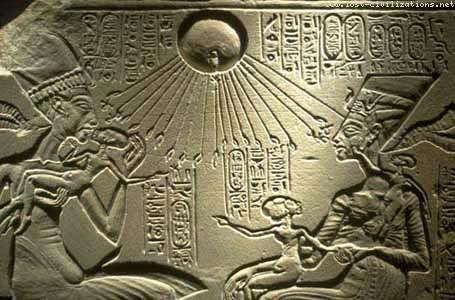 Akhenaton tried everything he could to personalize faith in the Aten and draw people away from their covert support of the old religion, but all the pharaoh-as-regular-guy art and esoteric discussions on the nature of life-giving energy couldn’t compete with centuries of hoary tradition. The people grudgingly did what the pharaoh told them to do, but it must have been apparent to all concerned that Akhenaton’s religion wasn’t going to survive his term in office, especially since the Aten seemed unable to protect Egypt from a series of plagues or pandemics during the Amarna Period. These could well represent the first influenza outbreaks in human history – new agricultural techniques were bringing humans into contact with mixed-up waste from waterfowl and pigs – but regardless, the Sun Disc appeared unable to help.
Akhenaton tried everything he could to personalize faith in the Aten and draw people away from their covert support of the old religion, but all the pharaoh-as-regular-guy art and esoteric discussions on the nature of life-giving energy couldn’t compete with centuries of hoary tradition. The people grudgingly did what the pharaoh told them to do, but it must have been apparent to all concerned that Akhenaton’s religion wasn’t going to survive his term in office, especially since the Aten seemed unable to protect Egypt from a series of plagues or pandemics during the Amarna Period. These could well represent the first influenza outbreaks in human history – new agricultural techniques were bringing humans into contact with mixed-up waste from waterfowl and pigs – but regardless, the Sun Disc appeared unable to help.
Akhenaton died in the 17th year of his reign (1336 BCE), having failed to carve enough of a foothold for the Aten-faith to ensure that his religion would live on. The immeadiate line of successors is a little unclear: it seems that someone named “Smenkhkare” assumed the pharaohship for a couple of years, but just who Smenkhare might have been is an object of speculation. Not a few folks think that it might have been Nefertiti in disguise:
All of the above would be cheerfully accepted as signs of a queen’s growing prestige if it weren’t for the “Smenkhkare question”. Nefertiti began life with a fairly simple name which later in the reign she changed to Neferneferuaten-Nefertiti. There is also, however, a record of Ankhkheperure-Neferneferuaten and Ankhkheperure-Smenkhkare. The latter ruled Egypt in the brief interval between Akhenaten and Tutankhamun. Do these names represent three different people, two people, or just one? It is possible that the switch in role from Great Wife to Pharaoh required a change to a more regal sounding name. If all three names are the same person it would fully explain the regal nature of some of the pictures of Nefertiti and how she disappeared so completely.
Around 1334 BCE, Smenkhare was succeeded by Akhenaton’s 9-year-old son, Tutankhaten (there’s debate about Tut’s parentage, with some thinking that he was a late-born son of Amenhotep III, or of Smenkhare). Within a couple of years, the returning power of the priests became evident, as the kid changed his name from “Living Image of the Aten” to Tutankhamen, or “Living Image of Amun.” He – or, more likely, his vizier and successor, Ay – began the process of de-Atenization by returning the capital to Thebes, restoring the privileges of the priests, and the temples of Amun-Ra were rebuilt.
In the Wake of the Wierdness
Tut’s reign lasted only 9 years; he died under what may have been mysterious circumstances at the age of 18 and was hastily buried in what ultimately became the only pharaoh’s tomb to be discovered intact. Though the spin on the curse which “protected” the sarcophagus has all the earmarks of a Dana Perino propaganda job, the mind-boggling wealth of his burial chamber belies Tut’s short, pretty much insignificant reign.
Ay – an old man when he came to the throne by marrying Tutankhamen’s widow, who was likely his granddaughter – continued the heretic practices of Akhenaton, but he was unable and/or unwilling to staunch the flow of worshippers heading back to the old ways. He only lasted about 4 years on the throne, afterwhich he was replaced by the decidedly anti-Aten Horemheb, the last pharaoh of the 18th Dynasty. A military leader who was probably fighting in Syria at the time of Ay’s ascension, Horemheb was an ambitious man who won some sort of power struggle in gaining the throne – a triumph he credited to his local god, Horus of Hnes, and not the Sun Disc – and solidified his claim by marrying a woman who might have been Neferetiti’s sister.
Horemheb was a strong, no-BS leader, who moved to strike Akhenaton from the historical record even as he sought to avoid returning all their previously-enjoyed powers to the priests (there’s debate on this, too: some hold that Horemheb was simply enforcing de-Atenization policies started under Tut and Ay). To re-build the temples of Amun and the others, he allowed for the destruction of the temples of the Aten and the use of their blocks as foundation stones and recycled rubble-fill. Horemheb also acted strongly to curb corruption, which had become a bit of a problem under Akhenaton’s ill-thought-out restructuring:
Though these documents known as the Great Edict of Horemheb, he apparently invoked harsh punishments for those found guilty of corruption. Abuses included the unlawful requisitioning of boats and slaves, the theft of cattle hides, the illegal taxation of private farmland and fraud in assessing lawful taxes and the extortion of local mayors by officials responsible for organizing the king’s annual visit to the Opet Festival. Convicted officials faced the removal of their noses and then exile, while soldiers who stole animal hides, for example were subject to a hundred blows and five open wounds. In fact, there seems to have been a whole body of laws intended to stamp out widespread bribery and corruption. Many of these problems have been viewed as the result of the iconoclastic policy of Akhenaten, whose disruption of the traditional temple based economy had opened the door to all kinds of excesses by local administrators, as well as military officials.
Horemheb ruled for around 30 years, and during that time, Egypt rang with blows of hammers smashing Akhenaton’s images and working over mentions of him in the bas-relief. By the time Horemheb’s successor confirmed the start of the 19th Dynasty, Akhenaton was already a 40-years-dead memory, and since nobody except a handful of Amarna-dwellers remembered his reign as “the good ole’ days,” their doesn’t seem to have evolved a group dedicated to preserving his memory. Or perhaps they did: Sigmund Freud’s last marriage of syphilis and the typewriter, entitled Moses and Monotheism (1939), argued that Moses had been an Atenist priest forced to leave Egypt with his followers after Akhenaten’s death. (I must confess to not having read the book, and furthermore, to cheating via this study guide – u.m.)
The de-Atenizers were meticulous, but they weren’t perfect – evidence of Akhenaton’s remarkable reign started to surface in the 19th century. Still, it’s a testament to their destructive capacity – to think: they did it all without electric papyrus-shredders! – that the priests of Amun and the other dissed gods of the Egyptians were able to obscure enough of Akhenaton’s reign that he got little credit for his failed innovations. His reign became an early anomaly rather then a generative source for artistic or theological movements, and for more than two millennia, his name was spoken with contempt, on those rare occasions it was spoken at all.
Historiorant:
 So what’s all this got to do with George W. Bush? I dunno; it was Huckabee’s proclamation that the Almighty is manipulating his poll numbers and Willard’s chilling assertion that freedom is impossible without religion that got me thinking about Akhenaton and his visionary/boneheaded/ham-handed reforms. If nothing else, I guess the story shows that “this, too, shall pass” – that it could be upwards of 2000 years before George Bush’s name is spoken with anything approaching respect. So we got going for us, even if we haven’t found our own Horemheb yet…
So what’s all this got to do with George W. Bush? I dunno; it was Huckabee’s proclamation that the Almighty is manipulating his poll numbers and Willard’s chilling assertion that freedom is impossible without religion that got me thinking about Akhenaton and his visionary/boneheaded/ham-handed reforms. If nothing else, I guess the story shows that “this, too, shall pass” – that it could be upwards of 2000 years before George Bush’s name is spoken with anything approaching respect. So we got going for us, even if we haven’t found our own Horemheb yet…
Historically hip entrances to the Cave of the Moonbat can be found at Daily Kos, Never In Our Names, Bits of News, Progressive Historians, and DocuDharma.

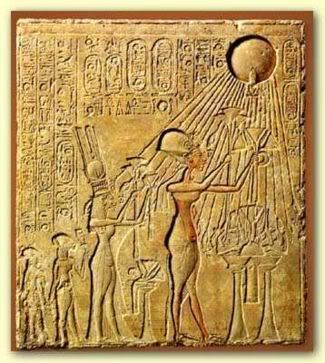
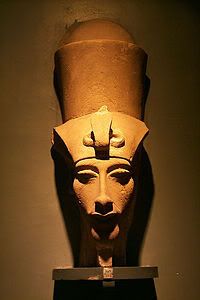

12 comments
Skip to comment form
Author
should we be thinking of as the New Akhenaton?
Apologies, btw, for the dearth of moonbattery last week – it’s finals time, and the day job’s been keeping me pretty well booked up…
is a must. I learn so much.
Thank you.
(serious paper) I did in school was about Akhenaton. I was in the 7th grade and I loved this tale. The Sun god image on the cover was a masterpiece. You version is less idealistic and closer to the truth then my report so thanks for this view. As an adult I can see the Separation of Church and State issues involved in a much different light.
WIKI ON AKHENATEN AND THE ARTS
Phillip Glass, Thomas Mann, Mahfouz et al. Not bad.
I was working on the Zine and saw this pop up. Very impressive. I wish my brain worked at half the functional capacity as yours.